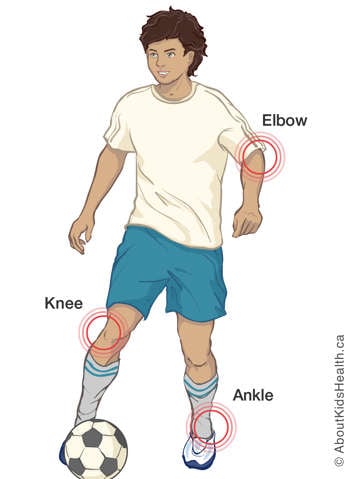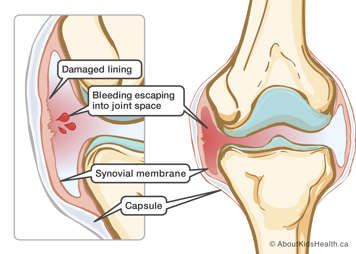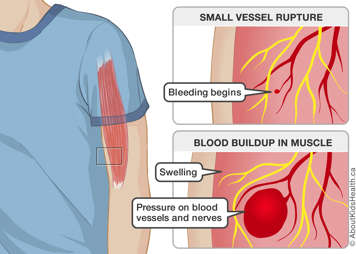The two most common types of bleeds in hemophilia are joint bleeds and muscle bleeds.
Joint bleeds

The place where two bones meet is called a joint. It is surrounded by a soft-tissue membrane, called the synovium. The synovium contains blood vessels of various sizes. An injury damages these blood vessels, causing blood to enter into the joint and surrounding area. The blood damages not only the synovium, but the bones and cartilage.
Cartilage is the soft tissue that helps protect bones. What do you think happens when a bleed weakens that protective layer around our bones? Without cartilage, the bones are able to grind against each other. This further damages the joint.
Not all joints bleed to the same degree. The most common bleeds are in the ankles, knees and elbows (these are known as index joints).
How to treat a joint bleed
Treat the bleed with factor and appropriately apply the principles of RICE, which you will learn more about in the Accessing Emergency Care page. Your physiotherapist can suggest ways you can get back on track after a bleed. Try light strengthening exercises to test the integrity of your joint first.
Rest your damaged joint longer than you think you should
It’s easy to feel tempted to start playing sports more aggressively once your joint looks like it has healed. However, it is important to fully rest your joint, because once a bleed happens you are more likely to bleed into that same joint again. Ideally, you want to wait at least two weeks to allow complete healing. Even if your joint looks and feels OK, it is in fact still healing. If you start using the joint more rigorously before it’s fully healed, you can prolong the entire healing process. Ask a member of your comprehensive care team (CCT) to examine your joint. They may advise you to take more product or start a prophylaxis treatment to speed up your joint recovery. This will help preserve your joint and allow it to fully heal.


Muscle bleeds
Your muscles contain a large amount of blood. The blood supplies oxygen which helps fuel your muscles. There are several ways you can rupture muscle fibers and cause bleeding. Direct impact is an obvious one, but did you know that strenuously using a muscle can also cause damage? Do not rely on visible signs that you have damaged your muscle, like bruising or swelling. For instance, it is common to feel tightness in a muscle that is bleeding because it is trying to heal itself. When you have a muscle bleed, your muscle feels weak. It will also feel painful. Bleeds are common in muscles, so talk to your physiotherapist for guidance. With sufficient time and rest, they should heal nicely.

You are more likely to bleed into the same muscle
Just like joints, the same muscle is now more likely to bleed again. Try to take it easy and slowly increase how often you use that muscle.
With proper preparation, it is possible to avoid many of the pathways to getting muscle bleeds. Talk to your physiotherapist about exercises to help strengthen your muscles. Use the best equipment to protect your muscles, such as protective padding.






